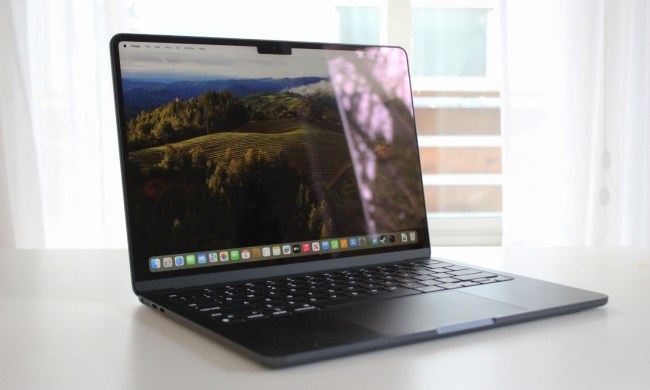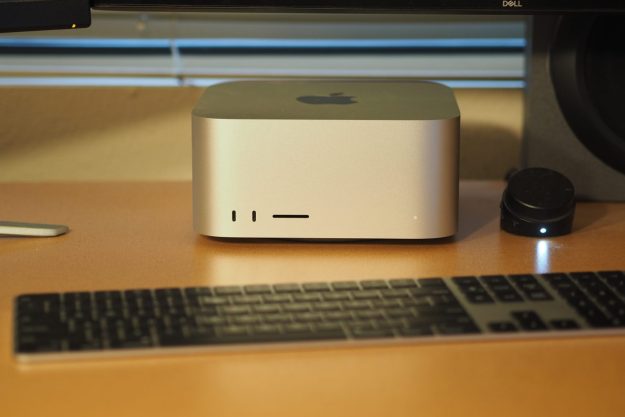
- Superior build quality
- Small chassis
- Solid connectivity
- Excellent creativity performance
- Quiet operation
- Elegant aesthetic
- Expensive
- Mediocre gaming
The Mac Studio came out in 2022 and was updated with the latest M2 chips in 2023. Filling the ground between the affordable Mac mini and the expandable Mac Pro, the Mac Studio is a classic middle child fighting for an identity.
Its strength, of course, is that the Mac Studio packs a lot of power into a very small format and plenty of ports. In my transition to an all-Apple ecosystem, moving away from my Windows desktop tower was saved for last, and I came into my testing to see how well the Mac Studio might replace it. To my surprise, I found it a highly capable machine, despite its limited expandability.
Specs and configurations
| Dimensions (HxWxD) | 3.7 x 7.7 x 7.7 inches |
| CPU/GPU | M2 Max 12-core CPU/30-core GPU M2 Max 12-core CPU/38-core GPU M2 Ultra 24-core CPU/60-core GPU M2 Ultra 24-core CPU/76-core GPU |
| Case | Apple CNC aluminum |
| Memory | 32GB unified (M2 Max) 64GB unified 96GB unified (M2 Max 38-core GPU) 128GB unified (M2 Ultra) 192GB unified (M2 Ultra) |
| Storage | 512GB SSD (M2 Max) 1TB SSD 2TB SSD 4TB SSD 8TB SSD |
| Power supply | Apple 370W |
| USB ports | 4 x USB-C with Thunderbolt 4 on rear 2 x USB-C on front (M2 Max) 2 x USB-C with Thunderbolt 4 on front (M2 Ultra) 2 x USB-A on back 1 x HDMI 1 x 10GB Ethernet 3.5mm audio jack on back SD card reader on front |
| Wireless | Wi-Fi 6E, Bluetooth 5.3 |
| Price | $1,999-plus |
The Mac Studio is available in two versions based on the chipset, either the M2 Max or the M2 Ultra. The table above shows that important configuration differences exist, including the amount of storage and RAM that can be selected and the port configuration. These things are important to remember when equipping your Mac Studio.
The least you’ll spend on a Mac Studio is $1,999, for an M2 Max 12/30, 32GB of RAM, and a 512GB SSD. The most you’ll spend for an M2 Max version is a much more expensive $5,399 for an M2 Max 12/38, 96GB of RAM, and an 8TB SSD.
The Mac Studio with the M2 Ultra starts at $3,999 for an M2 Ultra 24/60, 64GB of RAM, and a 1TB SSD. Fully configured, the Mac Studio is a whopping $8,799 for an M2 Ultra 24/76, 192GB of RAM, and an 8TB SSD.
This places the Mac Studio as a very premium desktop, and you’ll find Windows desktops that are more affordable and offer better performance. Note also that the Mac Studio is a sealed enclosure with no expandable components. What you buy is what you’ll get, forever, so choose wisely.
A floating block of pure industrial design
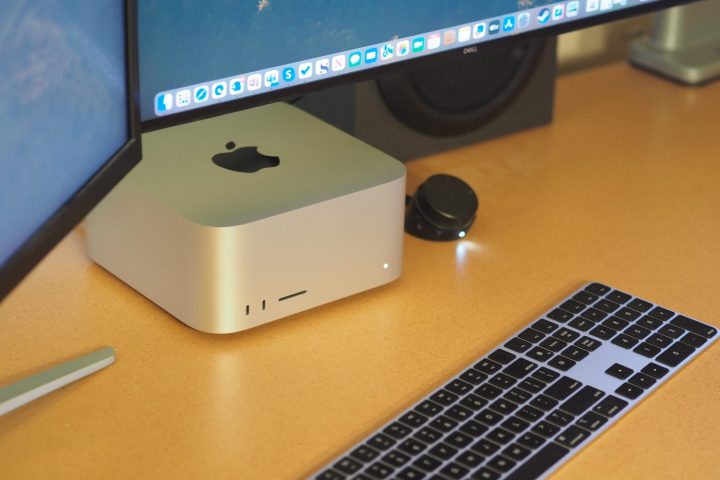
As is typical with Apple PCs today, the Mac Studio looks chiseled from a single block of aluminum — which is essentially what it is. The MacBooks have that aspect when they’re closed, and so does the Mac Mini. Even the iMac shares the appearance, albeit with a pane of glass melded in.
The Mac Studio epitomizes the same starkly elegant design, with any vents and seams hidden on the bottom or on the back, out of the way. Look at the Mac Studio from the usual slightly top-down angle when it’s sitting on a desktop, and it looks like a silver monolith floating a quarter-inch or so off the surface. A large chrome Apple logo sits on top as the only adornment. I like the aesthetic quite a bit.
There are two USB-C ports and an SD card reader upfront, but those look like carefully crafted cutouts. The USB-A, Ethernet, and HDMI ports are on the back, likely because those would expose more of their untidy internals. Having one or more of the former on the front might be more convenient, but that would break up the illusion.
The back is less tidy, with four USB-C ports, an audio jack, and a power connection to go with an exhaust vent that extends along the entire length. Note that the four USB-C ports on the back support Thunderbolt 4 on both chipset versions, while the front two are Thunderbolt 4 only with the M2 Ultra.
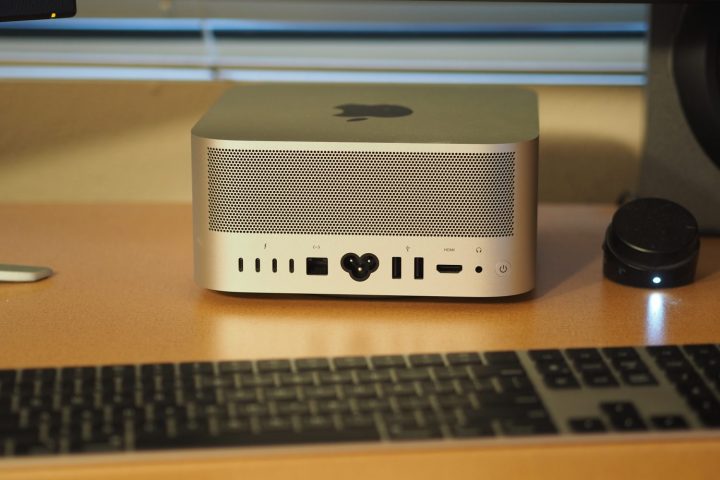
Clearly, Apple was going for a particular aesthetic, and that’s well-accomplished at the cost of some minor convenience.
The Mac Studio is also remarkably small, given the power inside. It’s less than 8 inches on each side and less than 4 inches tall, almost the same dimensions as two Mac Minis stacked on top of each other. It fits quite easily under my center 27-inch display, which is held up by a dual-monitor arm. The cables connecting to the three monitors and the Ethernet jack on my router are hidden in the back, making for an uncluttered appearance. If you’re connecting wirelessly to the internet, as well as to your keyboard and mouse, you’ll appreciate the Wi-Fi 6E and Bluetooth 5.3 support.
I’m using Apple’s Magic Keyboard with Touch ID, which is just as excellent as the keyboard on my MacBook Pro 14. My mouse is the Logitech MX Master 3S, which works perfectly with the Mac Studio and can also support my Windows desktop, which remains ready for standby use. I also connected to external speakers via the 3.5mm audio jack, because the built-in speaker is quite weak and best for system sounds only. If you want to connect a pair of headphones, you’ll be bummed that the connection is on the back, but you’ll appreciate the support for high-impedance cans.
Overall, the Mac Studio is an incredibly well-designed desktop that’s minimalist and incredibly attractive. It exudes solidity and quality and epitomizes Apple’s fastidious design sensibilities. You can find Windows mini-PCs that are similarly sized, like the HP Z2 Mini G9, but in my opinion, they’re not nearly as cohesively designed.
Very fast, very small, and very quiet, but not the fastest around

My Mac Studio is configured with the M2 Ultra, which is essentially two M2 Max chips glued together. It’s a bit more complicated than that, of course, but compare the specs and you’ll find twice the CPU and GPU cores. I chose the base 24-core CPU/60-core GPU rather than the 24-core/76-core version, simply because the latter is an additional $1,000 and the former is already overkill for my workflow. Both versions have CPUs with 16 performance cores and eight efficiency cores, the same 32-core Neural Engine, and a whopping 800GB/s of memory bandwidth. The only difference is the extra 16 GPU cores in the more expensive version.
As I ran through our suite of benchmarks, I was amazed at how quiet the Mac Studio remained throughout. No matter how demanding the process, the machine remained essentially inaudible. I had to put my ear to the Mac Studio to hear the fans running. It clearly benefits from a well-engineered cooling system, and it’s orders of magnitude quieter than my Windows desktop (a medium-sized tower that sits on the floor next to my desk). Windows mini-PCs are also much louder under high loads. Even the MacBook Pro gets louder when working hard.
Speaking of that, it’s important to take a moment to consider the MacBook Pro that’s now available with up to the M3 Max. That chipset is manufactured with the new 3nm node, improving on the 5nm process used in the M1 and M2 chipsets. That transition offers additional power and efficiency, letting Apple retain the same core counts with the new chipsets while boosting performance.
More important, though, are the improvements to the GPU, which now utilizes new technology like Dynamic Caching, hardware-accelerated ray tracing, and mesh shaders. The improved GPU shows up in gaming and applications that can utilize the GPU to speed up various processes.
Even the Neural Engine has been updated and is now considerably faster, and offers an advanced media engine that enables better hardware acceleration for various video codecs. Importantly, these updates speed up creative applications, making the new chipset even more powerful for creators.
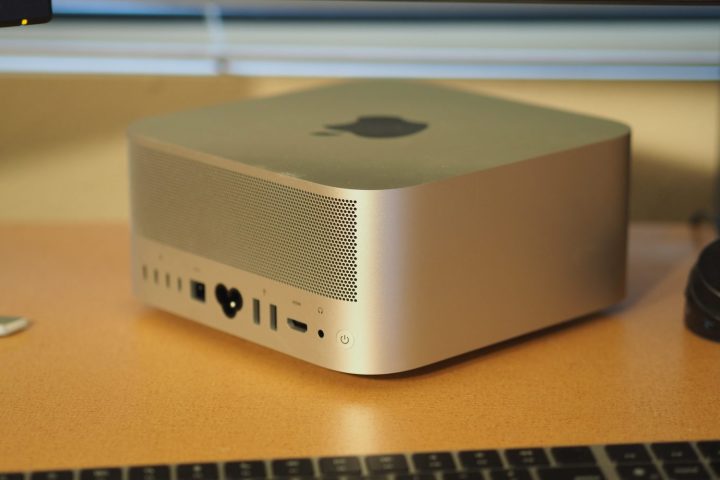
As we’ll see in the benchmark results, the MacBook Pro 14 with the M3 Max with 16 CPU cores and 40 GPU cores, a 16-core Neural Engine, and a 400GB/s memory bandwidth offers roughly the same performance as the M2 Ultra 24/60. Even the M2 Ultra 24/76 wouldn’t greatly exceed the MacBook’s performance. At some point in the future, probably in mid- to late 2024, Apple will likely introduce a Mac Studio with an M3 Ultra, which will certainly offer vastly improved performance over the M2 Ultra reviewed here.
The important takeaway from these results is that the Mac Studio with the M2 Ultra is a very fast PC, especially considering its diminutive stature and quiet operation. It’s not as fast as the fastest Windows desktops or the MacBook Pro with the M3 Max in certain benchmarks. In some cases, particularly where the GPU is concerned, it’s considerably slower.
In the all-important PugetBench Premiere Pro benchmark that runs in a live version of Adobe’s Premiere Pro, the Mac Studio is 10% faster than the MacBook and 17% slower than a powerful Windows desktop. You can certainly build or buy a Windows desktop that will provide faster performance at a lower price, whether you’re a gamer or a creator. But for MacOS users, the Mac Studio remains the best performance option, albeit by a slim margin over the M3 Max.
| Cinebench R24 single-core |
Cinebench R24 multi-core |
Cinebench R24 GPU |
Handbrake (in seconds) |
Pugetbench for Premiere Pro | |
| Mac Studio (M2 Ultra 24/60) |
120 | 1,870 | 7,727 | 56 | 978 |
| MacBook Pro 14 (M3 Max 16/40) |
139 | 1,522 | 12,765 | 53 | 889 |
| Custom Windows PC (Core i9-13900K/RTX 4090) |
126 | 2083 | 34,230 | N/A | 1,148 |
| Alienware Aurora R16 (Core i7-13700F/RTX 4070) |
112 | 1,070 | 16,974 | N/A | 828 |
| MacBook Pro (M2 Max) |
121 | 1032 | 5592 | 85 | N/A |
| iMac (M3 8/10) |
140 | 657 | 3728 | 112 | N/A |
Can it game?
Gaming on a Mac is better than ever, but it still lags Windows by a considerable margin. The biggest issue is the availability of top titles for MacOS. Simply put, it’s slim pickings. When I check my Steam account, I find only a handful of games that will run on my Mac Studio. I’m not a big gamer, so gaming performance isn’t terribly important to me.
Some decent games are available for the Mac, though, and I’ve checked out a few. First, in Civilization VI, the Mac Studio managed 65 frames per second (fps) at 1080p and ultra graphics. That’s well below Windows gaming PCs, but still playable, and oddly enough, the Mac Studio achieved almost exactly the same fps as I ramped up the resolution to 4K. I also ran Baldur’s Gate 3 and Fortnite, and both ran well at their default settings.
The M3 Max in the MacBook Pro will provide much stronger gaming, as will well-equipped Windows desktops. I wouldn’t recommend buying the Mac Studio for gaming, especially at such high prices.
Superior display support
Looking at these benchmark results, you may be considering a MacBook Pro with the M3 Max rather than the Mac Studio. That’s a reasonable proposition, but if you’re looking for a desktop configuration, you’ll want to carefully consider display support.
The Mac Studio with the M2 Max supports up to five displays. That’s four displays with 6K resolution at 60Hz via Thunderbolt 4, and another 4K display at 60Hz over the HDMI ports. You can also attach two displays at 6K and 60Hz and one 8K display at 60Hz or a 4K display at up to 240Hz via HDMI. The M2 Ultra version supports up to eight displays at 4K and 60Hz, up to six displays at 6K and 6Hz, and up to three displays at 8K and 60Hz. The HDMI port also supports a 4K display up to 240Hz. Of course, other combinations are also possible.
The MacBook Pro with the M3 Max supports up to four external displays, with three at 6K and 60Hz and one 4K resolution at up to 144Hz via HDMI. Or, you can run three external displays, one at 6K at 60Hz, one at 8K at 60Hz, and one 4K at up to 240Hz via HDMI.
It’s complicated, but the bottom line is that the Mac Studio supports more displays at higher resolutions and refresh rates. If you plan a complex multi-monitor setup, the Mac Studio is the better choice. Of course, as a desktop, you won’t be plugging and unplugging all those displays, although you could simplify things by using a Thunderbolt 4 dock with the MacBook Pro.
Expensive, but worth it
The Mac Studio is a standout desktop PC. It’s incredibly small given that it offers such excellent performance, and I’m still amazed at how quietly it runs even while working hard. The quality can’t be beat, which is typical of Apple products, and it provides plenty of connectivity and display support.
It’s also expensive, especially if you select the faster M2 Ultra model. You could buy a MacBook Pro 16 with similar specs and an M3 Max for a couple of hundred dollars more and enjoy equal or better performance, depending on your application. But the Mac Studio will support more displays and provide more ports out of the box. If you’re looking for a powerful desktop PC and are devoted to macOS, then the Mac Studio is an excellent choice.



